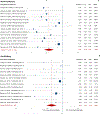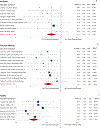HIV-associated executive dysfunction in the era of modern antiretroviral therapy: A systematic review and meta-analysis
- PMID: 28689493
- PMCID: PMC6164174
- DOI: 10.1080/13803395.2017.1349879
HIV-associated executive dysfunction in the era of modern antiretroviral therapy: A systematic review and meta-analysis
Abstract
Objective: While some reports suggest that HIV+ individuals continue to display executive function (EF) impairment in the era of cART, findings have been contradictory and appear to differ based on the aspect of EF being measured. To improve the understanding of how discrete executive abilities may be differentially affected or spared in the context of HIV infection, we conducted a systematic review and meta-analysis to (a) determine whether and to what extent HIV+ adults experience deficits in EFs, and (b) understand how demographic and clinical characteristics may modify the associations between HIV infection and executive abilities.
Method: Studies comparing HIV+ and HIV-uninfected groups on measures of working memory, set-shifting, inhibition, decision-making, and apathy between 2000 and 2017 were identified from three databases. Effect sizes (Cohen's d) were calculated using inverse variance weighted random effects models. Meta-regression was used to examine the moderating effect of demographic and clinical variables.
Results: Thirty-seven studies (n = 3935 HIV+; n = 2483 HIV-uninfected) were included in the meta-analysis. Pooled effect sizes for deficits associated with HIV infection were small for domains of set-shifting (d = -0.34, 95% CI [-0.47, -0.20]) and inhibition (d = -0.31, 95% CI [-0.40, -0.21]), somewhat larger for measures of decision-making (d = -0.41, 95% CI [-0.53, -0.28]) and working memory (d = -0.42, 95% CI [-0.59, -0.29]), and largest for apathy (d = -0.87, 95% CI [-1.09, -0.66]). Meta-regression demonstrated that age, sex, education, current CD4 count, and substance dependence differentially moderated the effects of HIV infection on specific EFs. However, lower nadir CD4 count was the only variable associated with greater deficits in nearly all EF domains.
Conclusions: Our results suggest that discrete domains of EF may be differentially affected by HIV infection and moderating demographic and clinical variables. These findings have implications for the development of targeted cognitive remediation strategies.
Keywords: HIV-associated neurocognitive disorder; HIV/AIDS; executive functioning; frontal lobe; neuropsychological functioning.
Conflict of interest statement
Figures



Similar articles
-
Empiric neurocognitive performance profile discovery and interpretation in HIV infection.J Neurovirol. 2019 Feb;25(1):72-84. doi: 10.1007/s13365-018-0685-6. Epub 2018 Dec 5. J Neurovirol. 2019. PMID: 30519968
-
CD4 nadir and neurocognitive trajectories in people living with HIV.J Neurovirol. 2024 Aug;30(4):423-433. doi: 10.1007/s13365-024-01217-8. Epub 2024 Jun 10. J Neurovirol. 2024. PMID: 38856821 Free PMC article.
-
Antiretroviral treatment initiation does not differentially alter neurocognitive functioning over time in youth with behaviorally acquired HIV.J Neurovirol. 2016 Apr;22(2):218-30. doi: 10.1007/s13365-015-0389-0. Epub 2015 Oct 13. J Neurovirol. 2016. PMID: 26463526 Free PMC article.
-
Executive function in HIV-affected children and adolescents: a systematic review and meta-analyses.AIDS Care. 2021 Jul;33(7):833-857. doi: 10.1080/09540121.2021.1873232. Epub 2021 Mar 25. AIDS Care. 2021. PMID: 33764813
-
Dementia and neurocognitive disorders due to HIV-1 infection.Semin Neurol. 2007 Feb;27(1):86-92. doi: 10.1055/s-2006-956759. Semin Neurol. 2007. PMID: 17226745 Review.
Cited by
-
Effects of Human Immunodeficiency Virus Infection and Former Cocaine Dependence on Neuroanatomical Measures and Neurocognitive Performance.Neuroscience. 2022 Oct 15;502:77-90. doi: 10.1016/j.neuroscience.2022.08.008. Epub 2022 Aug 11. Neuroscience. 2022. PMID: 35963584 Free PMC article.
-
Prediction of incidence of neurological disorders in HIV-infected persons in Taiwan: a nested case-control study.BMC Infect Dis. 2023 Nov 4;23(1):759. doi: 10.1186/s12879-023-08761-4. BMC Infect Dis. 2023. PMID: 37924043 Free PMC article.
-
Reduced neuronal population in the dorsolateral prefrontal cortex in infant macaques infected with simian immunodeficiency virus (SIV).J Neurovirol. 2021 Dec;27(6):923-935. doi: 10.1007/s13365-021-01019-2. Epub 2021 Sep 23. J Neurovirol. 2021. PMID: 34554407 Free PMC article.
-
Neurofunctional characteristics of executive control in older people with HIV infection: a comparison with Parkinson's disease.Brain Imaging Behav. 2022 Aug;16(4):1776-1793. doi: 10.1007/s11682-022-00645-6. Epub 2022 Mar 16. Brain Imaging Behav. 2022. PMID: 35294979 Free PMC article.
-
Effects of age, HIV, and HIV-associated clinical factors on neuropsychological functioning and brain regional volume in HIV+ patients on effective treatment.J Neurovirol. 2019 Feb;25(1):9-21. doi: 10.1007/s13365-018-0679-4. Epub 2018 Oct 8. J Neurovirol. 2019. PMID: 30298203 Free PMC article.
References
-
- Banich MT (2009). Executive function. The search for an integreated account. Current Directions in Psychological Science, 18, 1–20.
-
- Bechara A (2007). Iowa Gambling Task Professional Manual. Lutz, FL: Psychological Assessment Resources.
Publication types
MeSH terms
Grants and funding
LinkOut - more resources
Full Text Sources
Other Literature Sources
Medical
Research Materials
